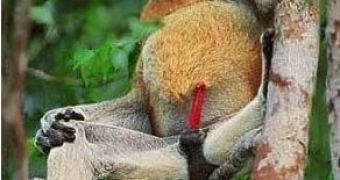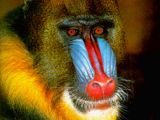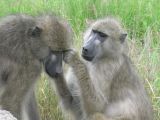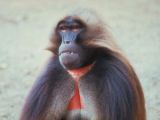Old World monkeys refer to the family of monkeys encountered in Africa and Asia. They are closer to apes (thus humans) than the monkeys of the Americas.
1.The main characteristic of the monkeys is their ability to process complex information and make subtle comparisons, taking decisions that help them adapt to the environmental changes. Macaques, guenons and langur monkeys have even learned to live near humans.
2.Monkeys sense their environment the way humans do: they have stereoscopic color sight and weak smell.
3.Very few monkeys are monogamous; most live in groups in which the access to females is determined by rank. Sometimes, a sole dominant male forestalls all the females; this is harem polygyny (like in the case of the gelada monkeys), while in other cases, more adult males coexist in the groups (multi-male polygyny), like in the case of the most macaques.
Monogamous species are the pig-tailed langur of Mentawai island and douc monkeys.
The size of a monkey group varies. Langur males can be solitary, but sometimes groups of monkeys can consist of 120 individuals. A group of mandrills contained over 1,300 individuals, the largest known group of monkeys. In many species, extra males and the immature ones form bachelor groups. Some species of monkeys, like langurs, are extremely territorial, defending fiercely their group territory.
Rhesus macaques live in large groups of about 85 individuals, organized matrilineally around high rank females. The rhesus monkey of a matrilineal group will defend each other against any external menace.
4.Grooming is more than a cleansing activity in monkeys; it is a way strengthening bonds, making friendships, achieving rank (when an inferior monkey grooms a high rank monkey), reduce aggressiveness and ...even to get sex in macaques, as males grooming females are more likely to enjoy a short party. Dominant males are clearly the most groomed individuals of the group.
Usually, the mother and brothers/sister groom monkey infants, but in the case of the Barbary macaque and the Taiwanese macaque, males are very involved in this. Usually, male macaques are very aggressive with each other, in their restricted rocky habitat, but grooming infants seems to calm them down. This behavior also makes the males more protective for the offspring against predators. The bonds made this way between older and young males are important for the harmony of the group.
5.Monkeys communicate through a large array of visual and vocal signals. Body position can indicate dominance or domination. Wrong postures are seen as defying and the individual could aspire to the supremacy of high rank monkeys. On guenon monkeys, the body language is underlined by colorful spots on the face, tail, thighs, and genitalia. This way the other monkeys always know the individual's sexual condition, rank, and intentions.
Monkeys, especially those from the savanna, have a large repertoire of vocal calls, a real speech. For example, they have different calls signaling the appearance of various predators: one for eagle, one for leopard, and one for snake. The short honk for the eagle makes the monkeys descend from the tree tops. Short strong yells for leopard send the monkey to the tree top. The high chatter for snakes makes the monkeys raise in two feet and look attentively around.
Monkey behavior is dominated by learning. Young monkey must learn body and vocal language to integrate in a group as adults. Like in humans, monkeys change voice from childhood to adulthood. The calls are essential in the emergence of new species, as differences in body language, color and calls (the "speaking" of different "dialects") can impede individuals mating amongst them and leads to new species of monkey. In fact, the species of Cercopithecus monkeys differentiate amongst themselves through their distinct facial patterns.
6.Monkey body language can be very deceptive. Sometimes, it looks sexual and is not. Females and males presenting their bottom to the dominant male, like inviting to copulation, just display submission, being meant to calm down. The alpha male can climb the servile monkey and even mimic copulation, accepting the submission.
Swelling the muzzle in the case of the offspring means they want to be breastfed. Lip laps display friendship and lack of hostility, while teeth chattering indicates a friendly posture, but submissive. Yawning in male baboons and mandrills is a very aggressive behavior. This way they menace the other members of the group, displaying the size of their huge canines teeth (even more than 5 cm (2 in) long, bigger than leopards'!).
7.Monkeys eat fruits, leaves, buds, shoots, roots, seeds and tubers depending on the season. They also consume insects and occasionally eggs and bird chicks. Mangabey monkeys pull out of the trees the bark while looking for insects. Some monkeys are known to steal crops, like langurs, rhesus macaques, baboons or guenons.
Gelada monkeys are unique amongst these mammals because they...graze. They sit on the ground, picking grass or seeds. Their robust fingers are adapted for pulling out roots.
The group of the leaf eating monkeys, like colobus, douc and langurs, feed mainly on leaves. Unlike fruits and seeds, leaves are available all year round, but they are hard to digest, and poor in nutrients, being made mainly be cellulose. Some are even poisonous. That's why these monkeys have a huge anterior chamber in their stomach, where bacteria digest cellulose and toxins are neutralized. That's why these monkeys have swollen bellies.
All the monkeys eat only during the daylight, roosting for protection during the night in trees or steep rocks, even the terrestrial species, like geladas, baboons, mandrills or rhesus macaques.
8.Monkeys live usually in forests, but guenons, patas and baboons live in the African savanna (patas only in western Africa). Patas monkeys have long legs and can run with 50 km (30 mi) per hour, being the most rapid primates on the ground.
9.In the African rain forest, 4-5 species of Cercopithecus monkeys can share the same forest area, on the same area, even on the same tree, as they are specialized to different levels of the trees.
Moreover, various species of monkeys can collaborate. For example, the Diana monkey (Cecopithecus diana) and red colobus monkey (Piliocolobus preussi), even if they live at same level of the forest in the Tai National Park (Ivory Coast), they do not compete for food (colobus monkey eat mainly leaves), but they have common predators: eagles, leopards, chimpanzees and humans. These species defend each other mutually. The colobus monkey can descend to the ground for feeding with termites, under the protective visual guarding of the Diana monkeys, which shout the alarm in case of danger. The Diana monkeys take advantage of the presence of the colobus monkeys, which, being larger, confront the eagles.
10.The largest monkey is the talapoin from the swamps of central Africa, while the largest monkey is the mandrill of also central Africa, whose male can be 50 kg (110 pounds) heavy.
11.The proboscis monkey live in swampy forests of Borneo, being a good swimmer. The long nose of the male hangs over his mouth and it is an important sexual signal. Females prefer long nosed males, so that from generation to generation the nose turns increasingly larger. Females have much smaller noses, but still larger than in other monkeys. The proboscis monkey is a leaf eater.
The male proboscis monkey has a harem of 8 females. He will chase away other males but also his own sons when getting mature out of the group. When a challenger wins and chases away the dominant male, he will kill all the offspring in the group, so that the females turn immediately in heat and carry his offspring. If the females dislike the new "sultan", they leave the group, joining another group. Some females make this for protecting their offspring. They can join groups of wandering young males, too weak to harm them.
12.Baboons can live in groups of hundreds. The groups are made of families, containing a dominant male and his harem. The families can organize in clans and bands. The members of the same band collaborate for chasing away predators, and the males can practice multi-male polygyny. The dominant male is extremely aggressive with the females, but if the females dislike the male, they can subtly invite an external male to invade the harem and steal them. In hamadryas baboons, the bond male-female can last for years.
Young male baboons attempt to form their own harem. They cannot confront mature males, so that young males form "friendships" with the immature females from their own clan. This way they can lure an adolescent female out of her mom. She can turn in his first partner.
13.You may have heard of rhesus factor from the blood. A rH negative mother, if having a rH positive offspring due to the father, can give birth to still babies or abort them, if they too are rH positive. That's because her body has formed antibodies which attack blood red cells from the baby's body (if it's rH positive). The baby's life can be saved if this is found early during the pregnancy, by administering immunoglobulin derived from the blood of rhesus macaques, which impedes the formation of antibodies in the mother's blood.
14.In India hanuman or gray langur monkeys and rhesus (and other) macaques are considered reincarnations of the monkey god, Hanuman, which burned his face and hands while stealing a mango (this monkey have black face, hands and feet). During the day of Hanuman, Hindu people make food offerings to the hanuman monkeys. Buddhists too consider sacred these monkeys, but they turned into a pest in many places where they attack crops and steal from houses and stores. In the spring, 75-90 % of the sacred rhesus macaques females of India and Nepal are pregnant. 75 % of them will give rise to live offspring; 75 % of the offspring survive their first years, and the population increases by 5-15 % annually if the resources allow it. Usually, a temple harbors about 300 rhesus macaques (meaning about 5 groups). The males are extremely aggressive during the mating season.
If a hanuman monkey female is ignored sexually by the male, she can start beating him and pulling out his fur.
15.Homosexuality is common with the Japanese macaques. Here, females form strong bonds with one another and temporary lesbian pairs during the mating season, ruling several partners during the whole period. They stimulate genitally each other and express their pleasure by cackling. That's why the links amongst females are extremely strong in a group.
In each group, there is an older dominant male that will have priority in copulating the females. The other male macaques practice homosexuality, but they do not form pairs, preferring an one-night stand.
In stumptail macaques too there is a frequent prolonged, intensive genital stimulation between individuals of the same sex, both males and females, adults and infants. Homosexual activities were accompanied by positive emotional facial expressions. During the first copulations of the young they are helped by adults of the same or opposite sex.
16.Most female monkeys possess buttock pads (ischial callosities), thick, hairless and brightly colored formations around their genitalia. These organs serve for sexual signaling and develop during the adolescence. When a female is in estrus, the pads swell and redden, and this is the signal a male needs and that a male will understand. Moreover, the female approaches the male exposing its rear zone, the male comes closer and they mate without any frontal contact.
But, in the bipedal position, the pads would be hidden. Gelada monkeys, which live in the Ethiopian plateau, have the genitalia surrounded by a vivid red skin portion, edged by white papilae. This pattern is imitated in the monkey's chest area, where a naked red skin patch is surrounded by white papilae. In the center of this particular chest region, the nipples got so close to one another that they strongly resemble the genital lips.
Like the genital area, the color of this skin patch varies along the menstrual cycle, being intense during the ovulation. What's very interesting and should be mentioned is that Geladas pass a lot of time in a vertical position, period when the genitalia are inconspicuous.
If kept in captivity without the possibility of reproducing, monkey females will have more swollen and vividly colored buttock pads than in the wild.
17.The male of many monkey species have vividly red penises and shiny blue scrotum (testicles' skin). The mandrill male's vivid blue and red face is mimicking its genital area, the red nose imitating the red buttocks, and the blue cheeks imitating the blue testicles. Female mandrills have much paler facial colors and much smaller blue areas.
18.Monkeys give birth to one offspring, rarely to twins, after a gestation of 140-220 days, depending on the species. Infants are usually cared one year, till the birth of the next offspring.
Social distance is the maximum distance to which on offspring can go off of its mother. The monkey mother keeps this distance through grimaces. In rhesus macaques, this distance is of 3 m (10 ft) at 2 weeks and 6 m (20 ft) at one month. In langurs, the social distance is 1.5 m (5 ft) at one month, and 6 m (20 ft) at 4 months. In the case of the baboons, this distance is of 3 m (10 ft) at 4 months, and 6 m (20 ft) at 8 months. For comparison with the apes, in gorillas, the social distance is of 3 m (10 ft) at 4 months and 6 m (20 ft) at 8 months.
19.Japanese macaques, the largest species of macaques, are one of the few monkeys that can withstand winters with temperatures below 0o C, in snow conditions of the Japanese mountains (other known monkeys to do this are some macaque species from China and Himalaya, and golden monkeys-Rhinopithecus- from the mountains of China).
They live in groups of 30-150 individuals and during winter, they snuggle into each other to get warm. In the large island of Honshu, some macaque populations have earned their fame for their habit of warming in the winter in thermal waters (in Shiga and Jigokudani "Hell's Valley", for example). They were even observed to practice some "physical activities" to get warm in winter.
20.The legend says that Gibraltar will be British as much there will be a colony of Barbary macaques (this is the only European population of monkeys, and even there are believed to have been brought by people). The British army takes care of these monkeys, but in their native Algeria and Morocco their number is dwindling.
21.There are 83 species of Old World monkeys grouped in 15 genera and two groups (subfamilies). The leaf eating monkeys (Colobinae) has been already mentioned. It is made of 37 species in 6 genera. The Cercopithecinae monkeys include talapoins, guenons, Cercopithecus monkeys, macaques, mangabeys, baboons, geladas, drills and mandrills. These monkeys have cheek pouches in which they can rapidly store foods, which they will chew when reaching a secure place.

 14 DAY TRIAL //
14 DAY TRIAL // 



